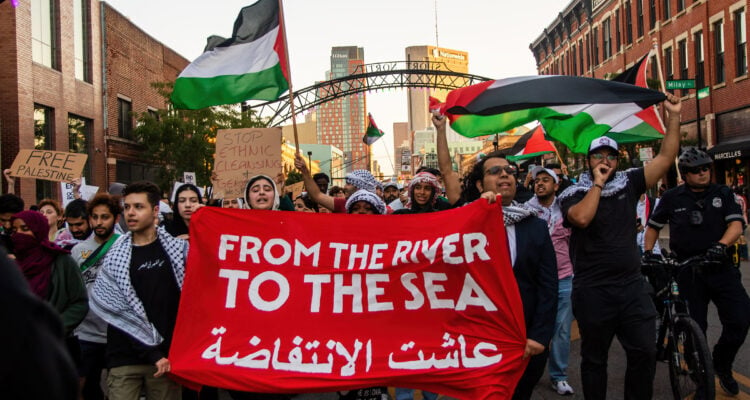|
Getting your Trinity Audio player ready...
|
Edited by: Fern Sidman
In the wake of a significant police operation to clear pro-Hamas protesters from Hamilton Hall at Columbia University earlier this week, new details have emerged regarding the identities of those arrested. According to the NYPD, more than a quarter of the individuals detained during Tuesday night’s action were not affiliated with the university, highlighting concerns about external involvement in campus protests.
The operation, which resulted in the arrest of 112 individuals, was initiated after it became evident that a significant number of participants were not students or faculty. As was reported by The New York Jewish Week on Thursday, the NYPD’s initial analysis indicated that 80 of those arrested were associated with Columbia, while the remaining 32 had no official ties to the institution. This distinction has become a critical point in discussions surrounding the protest, with New York City Mayor Eric Adams citing the involvement of “outside agitators” as a key justification for the police intervention.
The protesters arrested ranged widely in age, from 18 to 64, illustrating the diverse appeal of the cause beyond typical college-aged individuals. The New York Jewish Week also reported that they face several charges, including burglary, criminal mischief, resisting arrest, trespassing, and disorderly conduct. These charges reflect the seriousness with which authorities are treating the breach of peace and order on the university campus.
The involvement of non-affiliates in the protest has stirred significant debate regarding the influence of external groups on college protests, which are often seen as platforms for student activism. As was indicated in the New York Jewish Week report, Mayor Adams’s statement pointed out the extent of outsider participation, suggesting a need for greater scrutiny of who is participating in such campus activities and why.
The revelation that at least one of the arrested individuals was affiliated with Jewish Voice for Peace (JVP), an anti-Zionist group that has been active in similar encampments, adds another layer to the complexity of the situation. According to the information provided in the New York Jewish Week report, JVP’s involvement indicates that the protest drew support from organized groups with established positions on the Israeli-Hamas conflict, potentially influencing the nature and tone of the demonstration.
The presence of outsiders at the protest has raised questions about security and governance on campus, particularly regarding how universities can safeguard their spaces while respecting the right to free expression. For Columbia University, the challenge lies in balancing these elements in a manner that protects both the safety of the campus community and the democratic engagement of its student body.
Among those identified participating in the encampment were Lisa Fithian, 63, a veteran progressive activist known for her role in various social movements. Fithian was recognized in video footage from the takeover of Hamilton Hall at Columbia, as was reported by the New York Times. The New York Jewish Week also affirmed that another prominent figure, Nahla Al-Arian, also drew attention, particularly from New York City Mayor Eric Adams during an NPR interview. Adams expressed concern upon discovering that Al-Arian’s husband had previously faced federal terrorism charges, though Nahla herself was not arrested during the protests.
Nahla Al-Arian’s visit to the encampment became a focal point due to her husband, Sami Al-Arian’s, controversial history. Arrested in 2003 on accusations of supporting the Palestinian Islamic Jihad, a recognized terror group, Sami Al-Arian was not convicted of these charges but later pleaded guilty to a lesser charge in 2015, resulting in his deportation to Turkey, as was noted in the New York Jewish Week report. Nahla Al-Arian maintained that her presence at the encampment was passive, evidenced by a photograph posted by her husband on the social media platform X, showing her sitting outside a protest tent.
The encampment at Columbia University, which called for the university to divest from Israel and sever ties with Israeli academic institutions, became a site of daily gatherings and sometimes tense interactions with security forces, as was detailed in the New York Jewish Week report. Initially, the university’s response involved arresting over 100 individuals when the encampment was established. However, as the situation developed, the administration shifted strategies, opting for negotiations with the protesters in an attempt to resolve the stand-off amicably.
The response by the NYPD was a direct result of the protesters’ actions and the university’s subsequent invitation for intervention, given that police can only enter the private campus at the administration’s request or in life-threatening emergencies. Over the following days, law enforcement officers employed various methods to regain control of Hamilton Hall. As was pointed out in the New York Jewish Week report, videos released by the NYPD showcased officers scaling the building with a vehicle-mounted ladder, breaking through doors with hammers and crowbars, and cutting through chained doors with power saws. Scuffles with masked demonstrators further called attention to the intensity of the encounter.
The occupation and the university’s response have significantly impacted the Columbia community, especially Jewish students who expressed concerns to the New York Jewish Week about the presence of openly anti-Semitic protesters, many of whom they believed were not affiliated with Columbia.
The pattern of non-student involvement in university protests is not unique to Columbia. At the City College of New York, out of 102 protesters arrested, 68 were not students, accounting for approximately 60% of those detained, as was highlighted in the New York Jewish Week report.
The Jewish News Syndicate reported that less than half of the pro-Hamas protesters arrested at New York University last week after refusing to vacate the campus were members of the academic institution, the university said on Wednesday. Of the 133 protesters arrested on April 22 at Gould Plaza on campus, 65 were students, faculty or other employees of NYU.
Further complicating the dynamics at Columbia was the collaboration between student protesters and external pro-Hamas groups. Notably, in March, an unauthorized campus event titled “Resistance 101” featured speakers who openly praised Hamas, a designated terrorist organization by the United States and the European Union, the New York Jewish Week reported. The event included leaders from the pro-Hamas groups Within Our Lifetime and Samidoun, both known for their support of terror groups.




